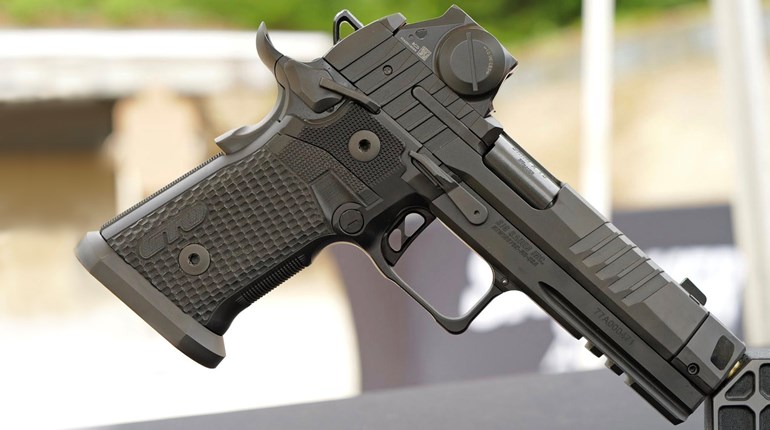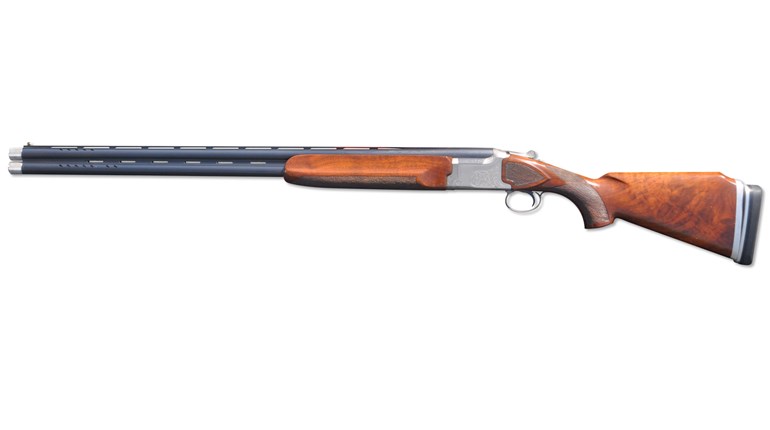
An old adage states, "You never know what you have until you lose it." That certainly was the case in 1963, when the Department of Defense, under Secretary of Defense Robert McNamara, began pulling the M14 battle rifle from the hands of our armed forces. In 1964, all further procurement of the M14 was curtailed, and by 1968 the U.S. Army had demoted the rifle from "Standard A" classification to "Limited Standard." To meet the specter of Vietnam, McNamara replaced the M14 rifle—which was considered too big and bulky for jungle warfare—with the new but untested M16.
In spite of the fact the M14 rifle weighed nearly as much as the M1 Garand it replaced, many soldiers were reluctant to give up the hard-hitting rifle. Some Marine units continued using it right up through the Tet Offensive. But basically, the M14 was only retained in South Korea and for European NATO operations, as well as by stateside troops such as the National Guard and recruits in basic training. Finally, in 1970, the rifle was retired from active duty.
Gone But Not Forgotten
The M14 was our last official 7.62 NATO battle rifle capable of firing in either full- or semi-automatic modes. It was famed for its jam-resistant action and superb accuracy. By contrast, the M16 fired the light, easily deflected 5.56 NATO cartridge that, due to its reliance on multiple hits, was predisposed to ammunition-wasting fully automatic fire.

"With the M16, if you shot three or four magazines, you had nothing to show for it," says Charlie McNeese, a Vietnam veteran who retired as a sergeant after four years in the Marine Corps. "Round count to body count went extremely high during the Vietnam War because we were shooting a lighter, less-lethal round and were taught to shoot fully automatic. But even then, the special units, the snipers, had M14s and M21s."
McNeese went on to spend the next 33 years in law enforcement with the Arizona Department of Public Safety, serving on its SWAT team, in criminal investigation and as the department's master firearms instructor and senior armorer. His love of the M14 never waned. Today McNeese is a rangemaster at Gunsite Academy, where, along with pistol, carbine and shotgun techniques, he teaches battle-rifle classes with the M14-style rifle. Although he carried an M16 in combat, he went through Marine Corps boot camp with an M14 rifle.
"It was an absolute work of art," McNeese recalls about his first issued M14. "I know that literally thousands of rounds had been fired through the rifle before I got it, and yet it was still highly accurate. We were putting rounds in the bullseye at 500 yards.

McNeese fondly remembers dry-firing his M14 from various field positions during "snapping in" week. Then it was on to live fire, where, after 300 to 400 rounds a day, he quickly came to appreciate the rifle's recoil-deadening weight. Perhaps above all, McNeese praises the M14's reliability.
"If properly lubricated, it would continue to function, even if it was dirty," he says. "There was not a time that I can remember that the weapon I used ever malfunctioned."
Rebuilt and Resurrected
Indeed, accuracy, reliability and perhaps a realization of "you never know what you have..." remorse are the elements that have brought the M14—and its civilian counterpart,the M1A—back, 47 years after it was drummed out of service. Part of this renewed focus on the M14 has been due to the war in Afghanistan, where long-range target acquisition well beyond the practical reach of the M16's 5.56 NATO round has become the norm. Those 500-yard targets are well within the M14's capabilities.

"At the platoon level, this weapon can dramatically increase the platoon's effective firing range," said SFC Michael Conner of the 101st Airborne Division's 4th Brigade Combat Team, from a forward operating base in Afghanistan's Khost Province in September 2008. Conner's unit was the first in Afghanistan to issue an updated version of the M14 known as the EBRMTT. Others have since followed.
Although hundreds of thousands of M14 rifles were demilled during the 1990s, enough of the 1,380,874 rifles originally produced between 1957 and 1964 remained to be pressed back into service, often after being outfitted with scopes for U.S. Army and Marine designated marksmen. However, the demands of modern warfare, including the development of body armor and the need for accessories such as lights, lasers and night-vision optics, have morphed the M14 into a rifle that often encompasses telescoping stocks and Picatinny rails. The trickle-down effect of this has produced a whole new generation of civilian-legal versions of the M14.
M14 or M1A?
Before reviewing some of the latest selections, it's important to differentiate between the military M14 rifle and the civilian M1A. At first glance, both rifles appear similar. However, the M14 has both fully automatic and semi-automatic fire capability. The M1A is semi-automatic only. Springfield Armory has trademarked the M1A name, which technically prevents others from using it unless they are building rifles with Springfield Armory's barreled actions.

Part of the confusion that sometimes exists between these two variations is because the M14 rifle is rarely used in the full-auto mode, and its selector switch—located on the right side, next to the rearward portion of the receiver—is often permanently disabled by a selector switch lock, a small cylindrical cap that prevents the shaft from rotating and tripping the sear for fully automatic fire.
With the M14's fully automatic cyclical rate of fire of 750 rounds per minute, the powerful 7.62 NATO cartridge causes the rifle's muzzle to rise dramatically within the first three bursts and makes the gun virtually uncontrollable. Even with a bipod, controlling the muzzle becomes a juggling match.
"When we fired the M14 on full-auto, the muzzle rise was just unbelievable," recalls McNeese. "They would get out of control. You had to be really close to the target and really careful or it would just climb right out of the backstop."
Obviously, only semi-automatic M1A and similar rifles are available to the vast majority of civilians. However, semi-auto M14-type rifles that use G.I. stocks, such as those built by James River Manufacturing, have a selector switch cutout. Re-enactors, collectors and others bent on an authentic look can obtain a non-functioning selector switch or a selector switch lock from Sparrow Hawk. Fulton Armory also makes an excellent, Parkerized, non-functioning selector switch.

Speaking of Fulton Armory, it should be noted the company classifies its semi-automatic rifles as M14s and marks receivers exactly like original G.I. versions, which only adds to the M14/M1A confusion. The reason for this, as company owner Clint McKee states, is "To keep the legend and spirit alive. It is an M14, after all." Of course, the M14 designation makes the rifle illegal in some states such as California.
To further complicate matters, James River Armory sells both reconditioned Springfield M1As as well as rebuilt rifles using its own receivers and lists them on its website as M14s, even though they are semi-automatic rifles.
Tough Choices
Another controversy anyone considering the purchase of an M14/M1A is going to encounter regards cast versus forged receivers. The common dictum is forged receivers are better, but this is debatable and has nothing to do with the practicality of shooting the rifle. Most of us will never fire enough rounds to tell the difference. The quality and condition of the barrel and inner parts are much more important factors.
On the other hand, it can't be denied there is a certain cachet to owning an M14/M1A with a forged receiver, but you have to pay for those bragging rights, since forged receivers are more expensive. If you plan on doing a fair amount of competitive shooting or are thinking of building your own top-of-the-line custom M1A, you may want to shell out for a forged receiver. By far the best choice are the hammer-forged, made-in-America receivers produced by LRB Arms.

LRB also offers complete rifles, including a standard government-issue M14 with a 22-inch barrel and an optional G.I. walnut stock, as well as a Tanker model with an 18.5-inch barrel and a fiberglass stock. Naturally, these rifles are built on LRB receivers, which are heat treated and hammer-forged from SAE 8620 steel bar stock and then CNC-machined to within .001 inch of mil-spec tolerances. In addition, the company sells an M14 Parts Kit for the do-it-yourselfer. This kit includes everything needed except the receiver, bolt and barrel, and is composed of both military surplus and newly made commercial parts.
Another source for a custom-built M14/M1A with an LRB receiver is James River Manufacturing. Former Marine 2nd/Lt. and owner Mark Hartman was one of the range officers in charge at Camp Lejeune, NC, where he shot Master Class High Power with the M14 rifle.
"The M14 had a good feel and pointed well," he recalled. "In 15 years of competition shooting, I never had an alibi. You just didn't have a problem with that rifle."
As a result of his admiration for the M14 rifle, Hartman now produces custom-built versions of the standard-issue rifle. It is a smooth-shooting rifle with an LRB receiver, TRW bolt, Krieger Criterion chrome-lined barrel and G.I. parts, including a refurbished original walnut stock complete with selector switch cutout and stamped with the correct Department of Defense acceptance cartouche.
Moving beyond the basic-issue rifle, the M14/M1A is now available in a plethora of variations, all based on the battlefield demands of this warhorse and its ability to meet those challenges in the civilian world as well. This age of specialization is perhaps best epitomized by Springfield Armory, which offers a wide selection of M1A variants. Its synthetic-stocked SOCOM 16 comes with a 10-round Parkerized magazine, sports a handy 16.25-inch barrel topped off with a proprietary muzzle brake, an XS Sight Systems tritium-insert front sight and a forward-mounted scope base.
The SOCOM II is a close-quarters battle rifle equipped with Springfield's exclusive Cluster Rail System for optics and accessories. It is available with either a matte-black or urban-camo stock, and is also offered with an extended top rail.
Springfield Armory's M21 is the civilian counterpart of the Army's M21 Sniper Rifle. It is the ultimate National Match shooting machine for longer ranges, with superior accuracy out to 750 yards. The rifle is equipped with an adjustable cheekpiece, a folding bipod and is available with either a Douglas Premium Air Gauged Custom Heavy Barrel or a stainless steel Krieger barrel.

With a small workforce of six people, Fulton Armory is perhaps one of the least known, but most highly respected, M14-style rifle builders. Its Mk14 Mod 0 Enhanced Battle Rifle (EBR) is a semi-automatic version of the highly modified M14 requested by U.S. Naval Special Warfare Command in 2004, primarily for use by Navy SEALs. With a Sage Industries aluminum, telescoping designated marksman stock and Picatinny rail, it is safe to assume John Garand never envisioned anything like this for his M14. Like all of Fulton Armory's M14 variants, the EBR utilizes parts from U.S. G.I. suppliers and features a mil-spec "lost wax" investment-cast receiver made of 8620 steel, precision machined and heat treated per military specs.
McMillan has also embraced the M14/M1A market by coming out with two new variants, both featuring fiberglass stocks and Springfield M1A barreled actions. Its M3A has a full-length upper handguard tactical rail and an adjustable saddle-type cheekpiece. McMillan's own M1A has the company's SOCOM adjustable folding stock. Both are available in an optional package that includes scope, bipod, leather sling and drag bag.
"There's a legacy with the M1A," says the company's vice president Ryan McMillan. "It's a historic battle rifle and some people want the high-end version of it, so that's what we decided to build."
High-end performance is why the J. Allen Enterprises JAE-100 G3 composite stock is so popular. It can be installed in less than 15 minutes, and the full-length aluminum skeleton eliminates the need for glass bedding. Yet, with its system of anchoring the barreled action with just two locking lugs and a barrel-tension screw, accuracy is dramatically enhanced.
There is a raft of aftermarket accessories—like VLTOR Picatinny rails and stocks, Trijicon sights, optics from companies such as Aimpoint and Leupold, and muzzle brakes from suppliers like SureFire and Young Manufacturing, as well as internal parts by firms such as Smith Enterprise—that can enhance the M14/M1A. On my Springfield Armory M1A Scout Squad, I installed Sadlak Industries' National Match solid spring guide for smoother operation, and I replaced the factory gas cylinder with the Sadlak titanium-nitride coated piston to guard against corrosion.
Whether through new design enhancements or the installation of aftermarket parts, the M14/M1A—in both its military and civilian guises—has been brought back to life. The rifle has also been improved beyond anything in the past, enabling it to continue preserving our freedoms well into the 21st century.





































